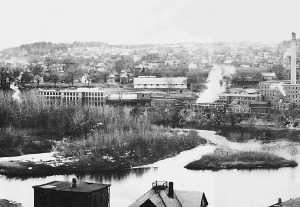By William E. Wargo, Esq., former City Attorney and Professor of Vermont History

5000 years ago! That is when archaeological research reveals that a single family band came to what is now the City of Winooski.
Harvesting the ample butternuts that grew here, the family soon moved on, but their prehistoric campground has become one of Vermont’s most significant archaeological sites. Other native people came to Winooski in the years that followed.
Time too has moved on. But Winooski has continued to play an important role in Vermont’s history and development. In the early 1770’s Ira Allen “led a people through a wilderness of 70 miles” to construct a formidable blockhouse on the Winooski (then “Onion”) River which served both as a fort and as general store and office for the land-speculating Onion River Company. “Fort Frederick” was never used for defense, but its protective presence increased value of Onion River property and advanced local settlement.
After the Revolutionary War, Ira Allen returned to build a dam across the Winooski River with sawmills at each end. The use of the Winooski falls to generate energy had begun; it would continue into the 20th Century with the construction of water-powered mills on both sides of the river. Ira himself built a house on the present site of the Winooski Block around 1785 and enjoyed a garden which was described as “a paradise of fruits and flowers.”
The Winooski mills’ fortunes mirrored the highs and lows of American economic life and labor and eventually led to Winooski’s becoming a separate City on March 7, 1922. When the mills closed in 1954, Winooski was devastated, but the federally-funded Model Cities program, Community Development Block Grants, Urban Development Action Grants, and other public and private investment and effort enabled the City to experience a “Renaissance” in the 1980’s with the rehabilitation of deserted mill buildings and the revitalization of the City’s downtown. Two examples follow:
The Woolen Mill, a generally vacant and under-utilized former textile mill, located in the National Historical Mill District, was transformed into a vibrant combination of living and working space, including 163 apartments, and 20,000 square feet of office space. Overlooking the natural beauty of the falls on the Winooski River, and a dominant architectural feature in the downtown, this building was a key element of the downtown revitalization effort.
The Champlain Mill, also located in the heart of the district along the Winooski River, stood under-utilized for over twenty years as it passed through a series of multipurpose industrial uses. In 1981, the Champlain Mill was renovated into three floors of retail commercial space and two floors of office space. In the Champlain Mill’s 175,000 square feet, stores, restaurants and several offices have been established.
Obviously, a great deal has changed since people came to pick butternuts here 5,000 years ago!
